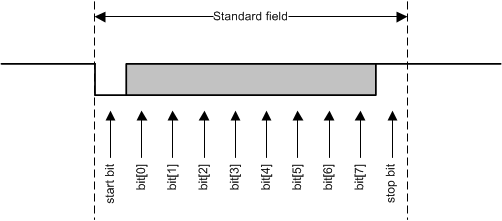SLASEJ4C April 2017 – February 2023 PGA460
PRODUCTION DATA
- 1 Features
- 2 Applications
- 3 Description
- 4 Revision History
- 5 Pin Configuration and Functions
-
6 Specifications
- 6.1 Absolute Maximum Ratings
- 6.2 ESD Ratings
- 6.3 Recommended Operating Conditions
- 6.4 Thermal Information
- 6.5 Internal Supply Regulators Characteristics
- 6.6 Transducer Driver Characteristics
- 6.7 Transducer Receiver Characteristics
- 6.8 Analog to Digital Converter Characteristics
- 6.9 Digital Signal Processing Characteristics
- 6.10 Temperature Sensor Characteristics
- 6.11 High-Voltage I/O Characteristics
- 6.12 Digital I/O Characteristics
- 6.13 EEPROM Characteristics
- 6.14 Timing Requirements
- 6.15 Switching Characteristics
- 6.16 Typical Characteristics
-
7 Detailed Description
- 7.1 Overview
- 7.2 Functional Block Diagram
- 7.3
Feature Description
- 7.3.1 Power-Supply Block
- 7.3.2 Burst Generation
- 7.3.3 Analog Front-End
- 7.3.4 Digital Signal Processing
- 7.3.5 System Diagnostics
- 7.3.6
Interface Description
- 7.3.6.1 Time-Command Interface
- 7.3.6.2
USART Interface
- 7.3.6.2.1 USART Asynchronous Mode
- 7.3.6.2.2 One-Wire UART Interface
- 7.3.6.2.3 Ultrasonic Object Detection Through UART Operations
- 7.3.6.3 In-System IO-Pin Interface Selection
- 7.3.7 Echo Data Dump
- 7.3.8 Low-Power Mode
- 7.3.9 Transducer Time and Temperature Decoupling
- 7.3.10 Memory CRC Calculation
- 7.3.11 Temperature Sensor and Temperature Data-Path
- 7.3.12 TEST Pin Functionality
- 7.4 Device Functional Modes
- 7.5 Programming
- 7.6 Register Maps
- 8 Application and Implementation
- 9 Device and Documentation Support
- 10Mechanical, Packaging, and Orderable Information
Package Options
Mechanical Data (Package|Pins)
- PW|16
Thermal pad, mechanical data (Package|Pins)
Orderable Information
7.3.6.2.1 USART Asynchronous Mode
The PGA460 device includes a USART digital communication interface. The main function of the USART is to enable writes to and reads from all addresses available for USART access. This function include access to most EEPROM-register and RAM-register memory locations on the PGA460 device. The USART asynchronous-mode (UART) digital communication is a controller-peripheral communication link in which the PGA460 is a peripheral device only. The controller sets when the data transmission begins and ends. The peripheral does not transmit data back to the controller until the controller commands it. A logic 1 value on the UART interface is defined as a recessive value (weak pullup on the RXD pin). A logic 0 value on the UART interface is defined as a dominant value (strong pulldown on the RXD pin).
The UART asynchronous-mode interface in PGA460 is designed for data-rates from 2400-bps to 115200-bps operation, where the data rate is automatically detected based on the sync field produced by the controller. Other parameters related to the operation of the UART interface include:
- Baud rate from 2400 bps to 115 200 bps, auto-detected (as previously described)
- 8 data bits
- 1 start bit
- 2 stop bit
- No parity bit
- No flow control
- Interfield wait time (required for 1 stop bit)
 Figure 7-18 USART Asynchronous Interface Bit Timing
Figure 7-18 USART Asynchronous Interface Bit Timing#X5128 shows the bit timing for USART asynchronous mode. Both data and control are in little endian format. Data is transmitted through the UART interface in byte-sized packets. The first bit of the packet field is the start bit (dominant). The next 8 bits of the field are data bits to be processed by the UART receiver. The final bit in the field is the stop bit (recessive). The combined byte of information, and the start and stop bits make up an UART field. #X2237 shows the standard field structure for a UART interface field.
 Figure 7-19 UART Interface Packet Field
Figure 7-19 UART Interface Packet FieldA group of fields makes up a transmission frame. A transmission frame is composed of the fields required to complete one transmission operation on the UART interface. #X9025 shows the structure of a data transmission operation in a transmission frame.
 Figure 7-20 UART Interface Transmission Frame
Figure 7-20 UART Interface Transmission FrameEach transmission frame must have a synchronization field and command field followed by a number of data fields. The sync field and command fields are always transmitted by the controller. The data fields can be transmitted either by the controller or the peripheral depending on the command given in the command field. The command field determines the direction of travel of the data fields (controller-to-peripheral or peripheral-to-controller). The number of data fields transmitted is also determined by the command in the command field. The interfield wait time is 1-bit long and is required for the peripheral or the controller to process data that has been received, or when data must change direction after the command field is sent and the peripheral must transmit data back to the controller. Time must be allowed for the controller and peripheral signal drivers to change direction. If the UART interface remains idle in either the logic 0 or logic 1 state for more than 15 ms, then the PGA460 communication resets and expects to receive a sync field as the next data transmission from the controller.